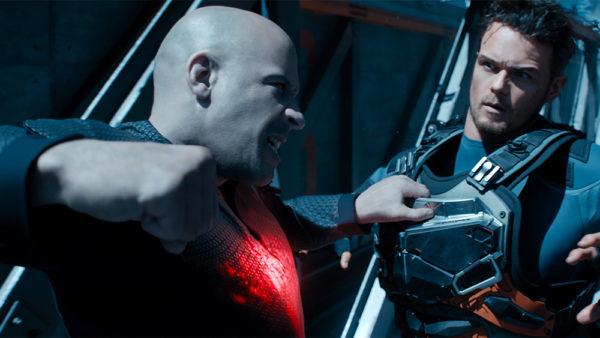
As far as “put your brain in park and enjoy the show” action movies go, Bloodshot definitely fits the bill.
Bloodshot is an adaptation of the Valiant comic created by Kevin VanHook, Don Perlin and Bob Layton. The film opens on Ray Garrison (Vin Diesel), a capable, independent soldier on a rescue mission in Kenya. He kills the baddie using his wits, then celebrates with an impromptu vacation with his wife Gina (Talulah Riley). Things very quickly go horribly awry, however, when they both are kidnapped and killed by baddie Martin Axe (Toby Kebbell).
At this point, Ray wakes up, revived and reconstituted by nanotechnology courtesy of Dr. Emil Harting (Guy Pearce). Harting is an independent weapons and technology manufacturer: he buys bodies from the military and has his own crew of technologically enhanced soldiers, including sexy KT (Eiza González), angry Dalton (Sam Heughan) and blind Tibbs (Alex Hernandez). When Ray recovers his memories, he goes rogue, using his newfound invincibility and wireless connectivity to track Axe to Hungary and attack his convoy in the film’s first big action sequence.
So far, so familiar, right?

Yes and no. The first act of the film, from a script adapted by Jeff Wadlow and Eric Heisserer, is rote and filled with clichéd action movie stereotypes. And yet, after Ray attacks Axe, Bloodshot unexpectedly acknowledges not just how formulaic it has been, and even deviates slightly to become a different type of action film. It’s still filled with unrealistic, explosive set pieces, dumb quips and plot holes, but these elements are much more forgivable when it’s evident that the screenwriters are aware of how silly it all is.
To be clear, Bloodshot never subverts audience expectations or becomes a smart action film, but by doubling down on its own inherent silliness and simply going for it, the film transcends its B-movie status to become an enjoyable diversion.
This is helped by a pair of delectably campy performances. First: Outlander star Heughan as Randal, a mercenary who is so aggressively annoyed and jealous of the attention heaped on Ray that it can’t help but smack of latent eroticism. And then there’s Pearce, whose Harting endlessly pontificates about the supremacy of his creations, all the while barking at his team like they’re subordinates – not super powered soldiers with the ability to scale 60 storey elevator shafts or ride motorcycles blind.

Like most contemporary action films, there’s also a dash of comedic relief. In Bloodshot this is embodied in two very different takes on the classic “techie” character: Eric (Siddharth Dhananjay), Harting’s right-hand operations man who is a huge loser in the eyes of his co-workers, and Winston (Lamorne Morris), a socially awkward blabber-mouth who becomes an unexpected ally of Ray’s. The humour is often quite broad and occasionally reliant on stereotypes, but it’s surprisingly not as off-putting as the hamfisted humour that tends to pop up in Hollywood popcorn flicks.
Not everyone fares quite as well. Diesel fails to distinguish Ray from his usual tough guy persona (FYI: this is closer to the Dominic Toretto end of the spectrum than Riddick). Despite a few scenes in which he’s clearly trying to emote, Diesel is the boring straight man of the film and his imposing physique is so blocky that it’s nearly distracting, particularly in the fight scenes that require him to do more than run through walls.
As the lone female character of note, González is fine, though she’s barely given anything to do. Thankfully there’s no effort to force a romance between KT and Ray, which excuses both actors from trying to conjure up onscreen chemistry. Sadly – and unsurprisingly – González (and to a lesser extent Riley) is heavily sexualized by director Dave Wilson’s camera; he uncomfortably takes advantage of every single opportunity to capture her lycra-clad ass. If there is one area that Bloodshot could have used an injection of modern sensibility, it would be in its lazy and stereotypical depiction of women who exist to do show up and look hot.

Ultimately the main reason to check the film out is its impressive FX. Wilson has a background in television and video games, and while at times his direction (and Jim May’s editing) would have benefitted from more coverage and significantly fewer music video-style cuts, when we can actually see the effect of the nanites as Ray is shot, beaten and blown up, Bloodshot looks impressive.
There are several exemplary action setpieces, including Axe’s tunnel shoot-out as the air is filled with flour and lit red by car headlights, as well as the climax set atop a plummeting elevator and featuring a visual reference to SpiderMan villain Doctor Octopus. Every simple details, like an exposition-laden encounter between Harting and Ray that takes place in an artificial virtual reality world that is literally constructed around them, works because it looks like a virtual reality simulation.
It is these instances, when the technical team knowingly acknowledges what kind of film they are making and how familiar audiences are with its narrative and visual tropes, that Bloodshot excels. The film may be formulaic in a lot of ways, but it’s also surprisingly smart. When it delivers, it’s good dumb fun.
3.5/5